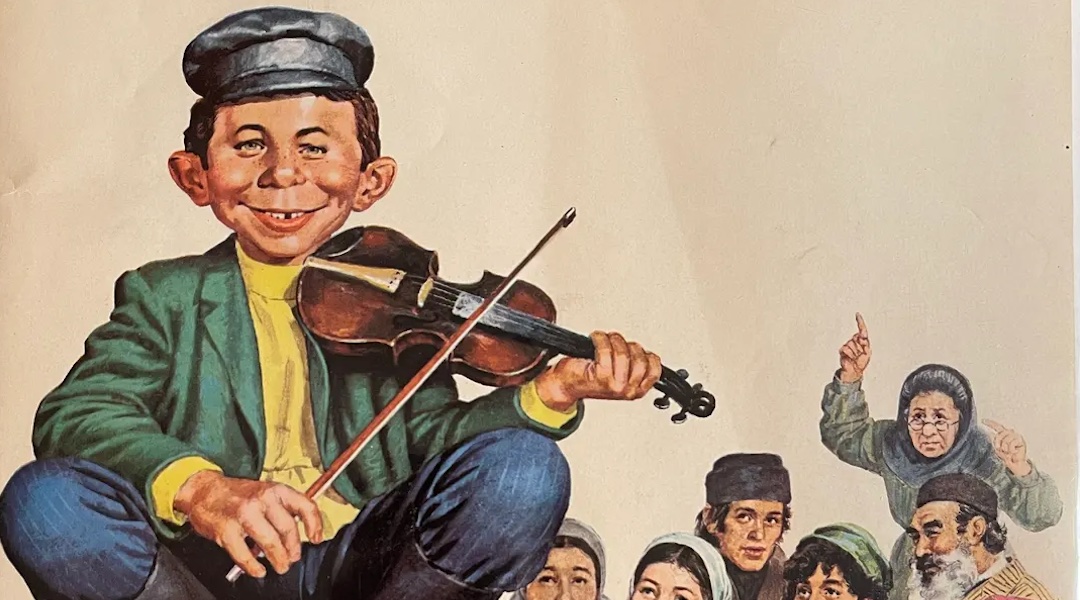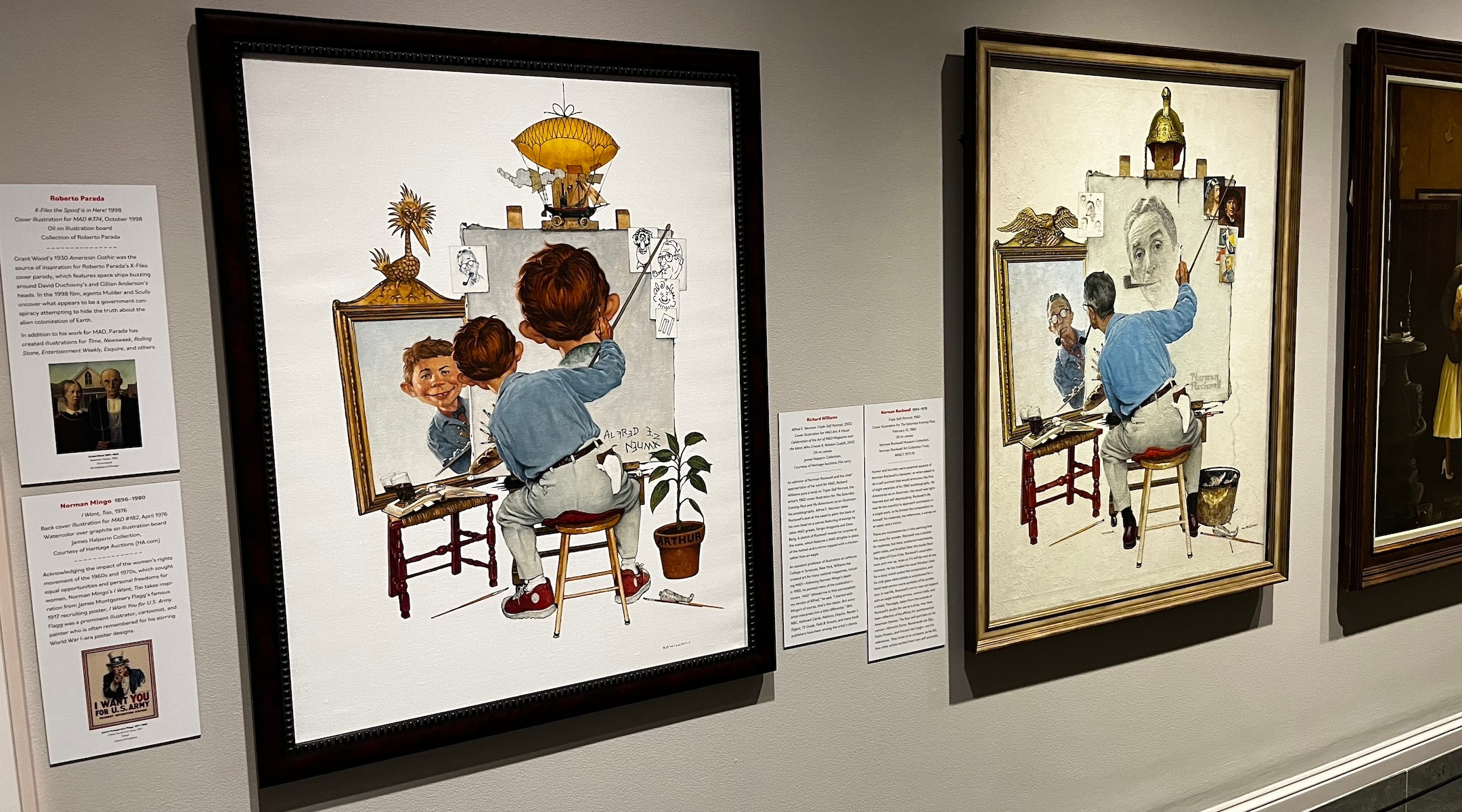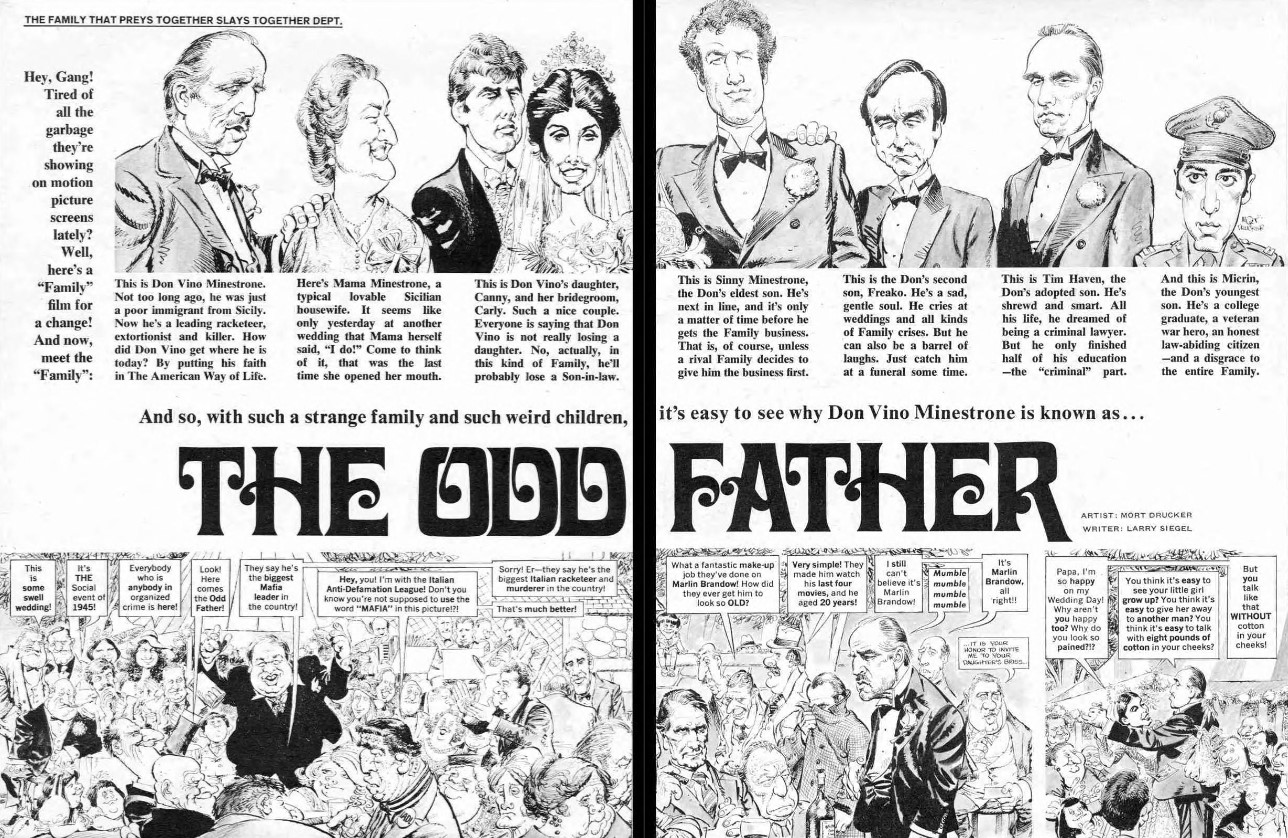
“What, Me Worry? The Art and Humor of MAD Magazine,” an exhibit at the Norman Rockwell Museum, features Norman Mingo’s 1973 cover illustration for MAD Magazine #156 depicting Alfred E. Neuman as a character in “Fiddler on the Roof.” (JTA Photo; MAD and all related elements © & ™ E.C. Publications. Courtesy of DC. All Rights Reserved. Used with permission.)
(JTA) — STOCKBRIDGE, Massachusetts — There’s a delightful “what if” moment at the start of “What, Me Worry? The Art and Humor of MAD Magazine,” a new exhibit at the Norman Rockwell Museum here.
In 1964, MAD commissioned Rockwell himself to paint a portrait of Alfred E. Neuman, the humor magazine’s gap-toothed mascot, as he might have looked in real life. Correspondence featured in the exhibit suggests that Rockwell — grand master of gentle, folksy, even cornball Americana — was close to signing on with what MAD called its “usual gang of idiots”: goofball masters of sophomoric, anti-establishment satire.
In the end, Rockwell turned down the offer. “I think I better back out of this one,” he wrote. “After talking with you, and my wife who has a lot more sense than I have, I feel that making a more realistic definitive portrait just wouldn’t do. I hate to be a quitter, but I’m afraid we would all get in a mess.”

We didn’t lose just a marriage of comic sensibilities, but of ethnic ones: the “goyish” and the Jewish, mid-20th century style. Rockwell’s world is full of farmers and fishermen, country folk and small-town shopkeepers. MAD seemed to have been born on the Lower East Side, come of age in the Bronx, and found its voice somewhere between Brooklyn and Broadway.
And as the exhibit makes clear, that impression is not far off. The MAD team in its heyday included founders William Gaines and Harvey Kurtzman, editor Al Feldstein, and artists and writers from Mort Drucker, Al Jaffee and Dave Berg to Larry Siegel, Stan Hart and, more recently, Drew Friedman, all Jews (and all men, I know). Its pages dripped with Yiddishisms, some real (shmuck!) and some imagined (furshlugginer!).

Norman Rockwell’s 1960 painting “Triple Self-Portrait,” right, is displayed next to Richard Williams’ 2002 parody, created for “Mad Art : A Visual Celebration of the Art of Mad Magazine and the Idiots Who Create It.” (JTA photo)
Nathan Abrams, in an article on MAD’s Jewish sensibility, argues that in the 1950s and ’60s the magazine “marinated in the same urban Jewish culture” that produced the New York Intellectuals, the mostly Jewish, mostly male writers and critics who dominated high-brow discourse from the 1930s through the 1960s. And its contributors had the same concerns, writes Abrams: “suburbia, psychoanalysis, existentialism, Freudianism, intellectual pretension, bohemianism, technology, disarmament, and containment.”
This Jewish sensibility abounds in the “What, Me Worry?” exhibit (whose name comes from Neuman’s catch-phrase). In a parody of “High Noon” from an early issue, a cowboy sings, “Do not forsake me oh-mah-dollink” in Yiddish dialect. In a later “Dick Tracy” lampoon, Al Pacino’s character, “Big Boy” in the original movie, becomes “Big Goy.”
A parody of “Funny Lady,” the 1975 sequel to “Funny Girl,” mocks Barbra Streisand’s take on Fanny Brice’s put-on Yiddish accent. “With that ‘Jewish’ routine, I think she’s killing Vaudeville,” says one audience-member. “Yeah,” says another, “but she’s adding new life to Anti-Semitism!”
The apotheosis of this deeply ethnic, self-mocking and even self-protective Jewish voice is found in the 1973 parody of “Fiddler on the Roof.” Titled “Antenna on the Roof,” it’s represented in the exhibit by the original cover painting of Neuman as the fiddler. Drucker and writer Frank Jacobs set the musical in a tinseled, clearly Jewish suburb, and changed the Sholem Aleichem adaptation into an angry indictment of Jewish assimilation.
“Now that we’ve seen the Mess you’ve made,” the villagers of Anatevka sing to a cast of nouveau riche Jews, “We’re afraid God wants back his melting pot!” It’s an entire Philip Roth novel in a seven-page comic.
In its heyday (roughly, IMHO, from the late 1950s to the mid-1970s), MAD also dissected and subverted consumer and pop culture with as much precision, and more impact, than thought journals like Commentary and Dissent. It taught young readers like me to be wary of corporate America, with parodies that undermined the cynical claims of advertisers. MAD also deconstructed TV shows and feature films, pointing out the cliches and conventions of popular culture before anyone knew what deconstruction was.

Mort Drucker (1929-2020) drew “The Oddfather,” a parody of the “The Godfather,” in 1972 for MAD #155. (Private Collection/MAD and all related elements © & ™ E.C. Publications. Courtesy of DC. All Rights Reserved. Used with permission.)
An accompanying exhibit, “Norman Rockwell: Illustrating Humor,” includes 20 examples of the charming, slice-of-life gags the artist created for middle-brow magazines like The Saturday Evening Post and McCall’s: frantic, half-dressed boys fleeing an off limits swimming hole, an unhappy babysitter pushing a carriage while his buddies head off to play baseball.
But if MAD and Rockwell appear to spring from different comic universes, the exhibit demonstrates what they had in common. After leaving The Post in 1963 after decades as its cover artist, Rockwell felt free to embark on a series of paintings depicting the political struggles of the day, including civil rights and the displacement of Native Americans.
Similarly, the exhibit explores how political MAD could be, noting that “beyond the laughs … MAD’s focus on national events and figures had great impact, raising public awareness during the mid-twentieth century when mainstream media was deferential to authority.” Equal opportunity offenders, MAD’s crew sharply ridiculed Richard Nixon, George McGovern and Henry Kissinger.
MAD stopped publishing fresh material monthly in 2019. You leave the exhibit wondering what it might have done with the two unpopular seniors running for president at the moment — although it’s hard to lampoon a campaign that already seems a parody of itself.
MAD and Rockwell also shared an obsessive attention to craft. Paintings by MAD cover artists like Norman Mingo and Kelly Freas demonstrate a mastery of technique that compares favorably to Rockwell’s work, which hangs nearby. Richard Williams’ parody of the famous “Triple Self-Portrait” by Rockwell wouldn’t be as funny if it weren’t as beautifully painted as the original.
I’ve been spending a lot of time in the Berkshires, where Rockwell lived and from which he literally drew his inspiration. The recent Jewish influence on this old bastion of Yankee New England can be seen everywhere: in the big Chabad house under construction in Lenox, in the Jewish film and lecture series that takes place throughout the summer, in the Judaica sold in the craft shops.
The MAD exhibit at the Norman Rockwell Museum suggests the merger that almost was — between gentile and Jewish, nostalgic and subversive, rural and urban, mild and meshuggeneh. I think Norman Rockwell and William Gaines would both have approved.
The views and opinions expressed in this article are those of the author and do not necessarily reflect the views of JTA or its parent company, 70 Faces Media.
Andrew Silow-Carroll is editor in chief of the New York Jewish Week and senior editor of the Jewish Telegraphic Agency. He previously served as JTA’s editor in chief and as editor in chief and CEO of the New Jersey Jewish News.
A message from our editor-in-chief Jodi Rudoren
We're building on 127 years of independent journalism to help you develop deeper connections to what it means to be Jewish today.
With so much at stake for the Jewish people right now — war, rising antisemitism, a high-stakes U.S. presidential election — American Jews depend on the Forward's perspective, integrity and courage.
— Jodi Rudoren, Editor-in-Chief